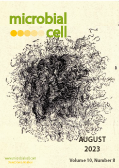Table of contents
Volume 10, Issue 8, pp. 157 - 177, August 2023
Cover: Image retrieved from "A textbook on disease-producing microorganisms: especially intended for the use of veterinary students and practitioners" (by Maximilian Joseph Herzog; published by Lea & Febiger, 1910), in which the caption reads "Colonies of bacillus antharacis upon gelatin plates at the end of forty-eight hours (x80, F. Flügge)"; image modified by MIC. The cover is published under the Creative Commons Attribution (CC BY) license.
Enlarge issue cover
Caspase 3 exhibits a yeast metacaspase proteostasis function that protects mitochondria from toxic TDP43 aggregates
Steve Brunette, Anupam Sharma, Ryan Bell, Lawrence Puente and Lynn A Megeney
Research Reports |
page 157-169 | 10.15698/mic2023.08.801 | Full text | PDF |
Abstract
Caspase 3 activation is a hallmark of cell death and there is a strong correlation between elevated protease activity and evolving pathology in neurodegenerative disease, such as amyotrophic lateral sclerosis (ALS). At the cellular level, ALS is characterized by protein aggregates and inclusions, comprising the RNA binding protein TDP-43, which are hypothesized to trigger pathogenic activation of caspase 3. However, a growing body of evidence indicates this protease is essential for ensuring cell viability during growth, differentiation and adaptation to stress. Here, we explored whether caspase 3 acts to disperse toxic protein aggregates, a proteostasis activity first ascribed to the distantly related yeast metacaspase ScMCA1. We demonstrate that human caspase 3 can functionally substitute for the ScMCA1 and limit protein aggregation in yeast, including TDP-43 inclusions. Proteomic analysis revealed that disrupting caspase 3 in the same yeast substitution model resulted in detrimental TDP-43/mitochondrial protein associations. Similarly, suppression of caspase 3, in either murine or human skeletal muscle cells, led to accumulation of TDP-43 aggregates and impaired mitochondrial function. These results suggest that caspase 3 is not inherently pathogenic, but may act as a compensatory proteostasis factor, to limit TDP-43 protein inclusions and protect organelle function in aggregation related degenerative disease.
Metallothionein Cup1 attenuates nitrosative stress in the yeast Saccharomyces cerevisiae
Yuki Yoshikawa, Ryo Nasuno, Naoki Takaya, Hiroshi Takagi
Research Reports |
page 170-177 | 10.15698/mic2023.08.802 | Full text | PDF |
Abstract
Metallothionein (MT), which is a small metal-binding protein with cysteine-rich motifs, functions in the detoxification of heavy metals in a variety of organisms. Even though previous studies suggest that MT is involved in the tolerance mechanisms against nitrosative stress induced by toxic levels of nitric oxide (NO) in mammalian cells, the physiological functions of MT in relation to NO have not been fully understood. In this study, we analyzed the functions of MT in nitrosative stress tolerance in the yeast Saccharomyces cerevisiae. Our phenotypic analyses showed that deletion or overexpression of the MT-encoding gene, CUP1, led to higher sensitivity or tolerance to nitrosative stress in S. cerevisiae cells, respectively. We further examined whether the yeast MT Cup1 in the cell-free lysate scavenges NO. These results showed that the cell-free lysate containing a higher level of Cup1 degraded NO more efficiently. On the other hand, the transcription level of CUP1 was not affected by nitrosative stress treatment. Our findings suggest that the yeast MT Cup1 contributes to nitrosative stress tolerance, possibly as a constitutive rather than an inducible defense mechanism.










